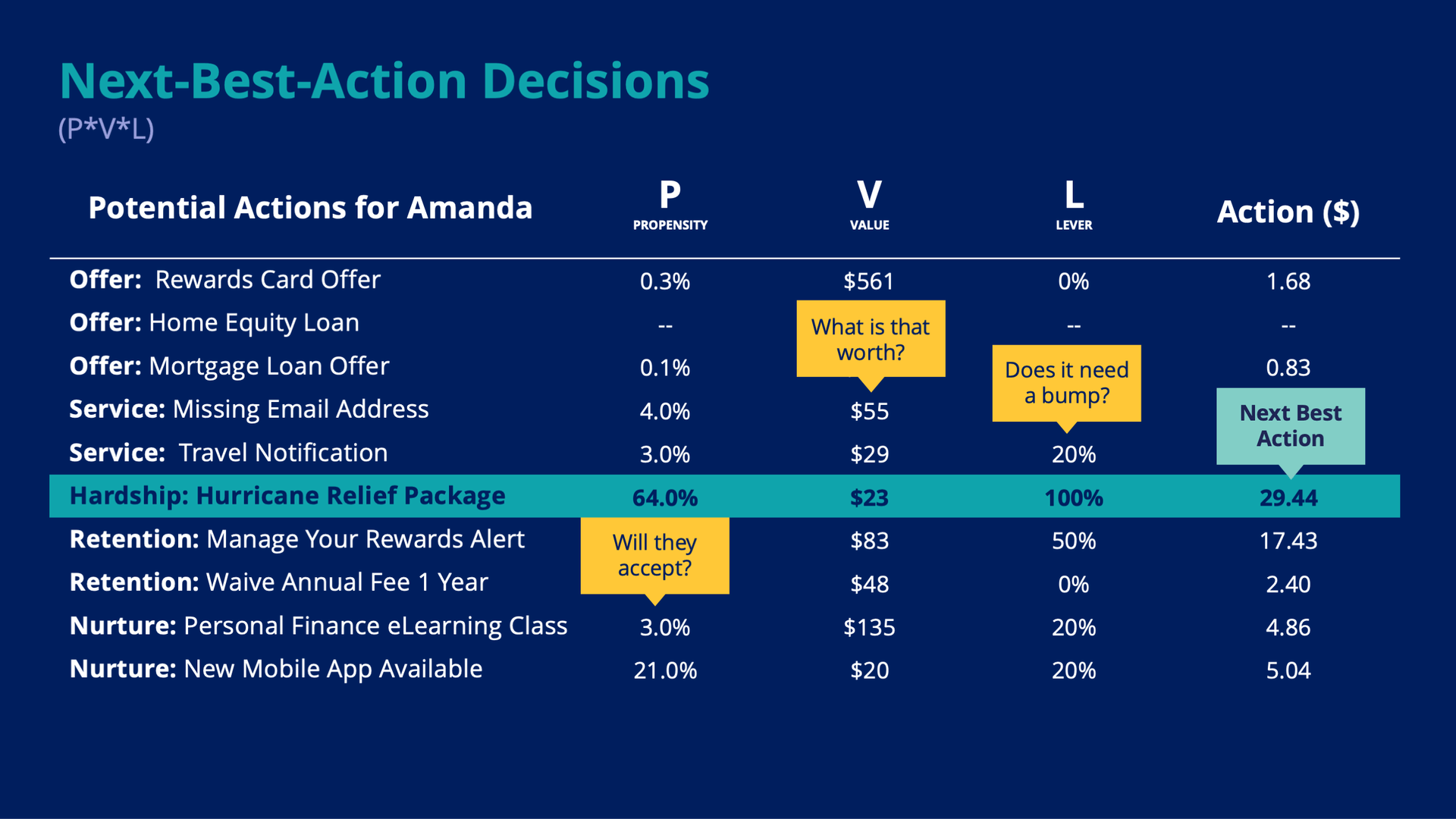The ultimate goal of any interaction is to deliver a great experience that builds and strengthens the relationship with your customer. Period. That could be as simple as making relevant information easy to find on your website, quickly and accurately responding to a customer inquiry, or pro-actively reaching out with an offer at just the right time. What’s important is that the customer feels cared for.
But with so many competitors and brands in the market, how do you differentiate?
2 out of every 3 customers believe that brands simply do not care about their needs
You can’t rely on the past to optimize the present. Customers’ expectations are at an all-time high, and outdated campaign tactics, broad-based segments, and scripted journeys no longer get the job done. The average campaign, in any market, gets less than a 1% response rate. That means 99 out of 100 people ignore everything you’re sending. It’s why opt-outs and unsubscribes are continuing to soar. Businesses are still focusing on what to sell, when they should be focused on what customers need.
Consumers expect you to know them. Understand them. They want you to talk directly to them about what’s uniquely important to their situation right now. If you can’t personalize your interactions and give you customers what they need when they need it, they’ll quickly drop you for another brand. Just one poor experience and they’re out the door.

Why Real-Time Really Matters
How to gain a competitive edge by delivering contextual next best actions
Success in today’s market comes from building real, meaningful, relationships where each conversation earns you the right to the next one.
To keep your customers, you need to connect with them in a way that is relevant, contextual, timely, and empathetic – all of which are key aspects of personalization.
Right now you might be thinking, “I’m managing billions of interactions for millions of customers, across hundreds of programs, and dozens of channels. How can I possibly personalize every one of those?”
Well, given your current marketing stack, you probably can’t. If you’re like most organizations out there, your stack is loaded with channel-specific solutions that weren’t built to work together or adapt to customer needs. It’s not your fault. There are literally 8,000 unique solutions available at this exact moment, all of which you can use to engage your customers across inbound, outbound, and paid. And while that sounds wonderful on the surface, in reality that’s about 8,000 too many. That’s 8,000 disconnected, siloed applications, each with their own brain – their own rules, their own data models, and their own unique ways of understanding and interacting with customers.
Even if your solutions are from the same vendor, they likely weren’t designed to work together – they were each built to help businesses like yours sell products to customers in big batches and large segments. They weren’t designed to help you be agile and solve customers’ problems, especially not in real-time. From a technology point of view, it’s preventing you from taking advantage of what you know and what your customers are telling you – and they end up getting lost in the shuffle.
The good news is, even with all that technical complexity, you can still take steps to interact with each customer in a way that’s relevant for them. You just have to change the way you think about customers and the way you go to market. Success in today’s world means constantly listening and analyzing customers’ needs – then adapting quickly enough to stay relevant and add value “in the moment.” Here’s how to do it:
Truly disruptive companies are rethinking their customer relationships from the ground up and focusing on three essential components for personalization
1. Centralize decisions: The first thing you need to do to deliver on the promise of real-time personalization is centralize your decision making.
At the end of the day there can only be one brain, one centralized decisioning authority to power all of your engagements. It sits at the center of all your channels, all of your different applications, and collects data from them – like what the customer is doing on your website right now, or what they’re saying to an agent, or if they’re opening your email. It combines this real-time data with all the historical information already in that customer’s interaction history, then based on this complete profile, it analyzes each customer in each unique moment to determine their context and if there is a next best action to take.
That action could be a personalized sales offer, a retention plan, service task, nurture effort, or even no action at all. But whatever it is, it’s determined in real-time using AI, adaptive models, and machine learning, then delivered back out across any channel – inbound, outbound, owned, paid, or even agent assisted. And all of this happens in less than 200 milliseconds.
2. Engage with empathy: At the heart of personalization is a person! To engage each customer as an individual requires you to get beyond your traditional product-push mindset and instead be able to pivot to things like service or retention in the moment, as your customer’s needs are changing. Remember, it’s next best action. Not next best offer.
But how do you know which action is the next best action? This is where the math and AI come in. At the highest level, the next best action is the one that best balances what’s best for the customer with what’s best for your business, all within the context of a given situation. Propensity (P) * Value (V) * Lever (L).
With a centralized brain in place, you’ll break down traditional silos between channel owners and lines of busines (LOBs). Instead of those groups competing with – or ignoring – one another you’ll start by telling the brain all of your potential actions – things like sales offers, service nudges, retention plans, nurture efforts, or maybe a hardship message. Whatever those actions are, they represent everything you could possibly do for this customer in this moment. The brain then determines the propensity of each customer to accept each action.
Then comes the value. Say the customer accepts your offer or opens your “happy birthday” message; what’s that worth to you as a business? This could be as simple as a margin calculation or as complex as an impact to customer lifetime value (CLV).
Then comes the lever, which can be used to adjust things up or down based on your current business situation. For example, if you’re behind plan you could boost a low propensity offer up. But be careful – going against propensity will decrease relevance, and ultimately undermine the experience.
Ultimately the action that we take, the next best action, is simply the one with the highest (P*V*L) score.

Use propensity, value, and levers to calculate your next-best-action.
But what is key about engaging with empathy is every time a new piece of data becomes available you re-decision the customer again and calculate a new next best action. The best brands are doing this five, 10, 20, even 50 times within a single interaction - driving a 5X increase in relevance.
3. Deliver in the moment: If you’re going to personalize the customer’s experience in real-time, it is not enough just to know what to do, you’ve got to get that decision out to the customer during their moment of need, then make sure you’re able to adapt that experience as their needs change. That may seem daunting given all of the channels in play today but having a centralized brain in your marketing stack builds agility to quickly adapt.
Take your website, for example. Instead of defaulting to a static experience or relying on segment-based personalization that’s updated in batch, now your content management system (CMS) will call into the centralized brain for a next best action and next best treatment decision for every container on the page, every time a customer arrives.
Or on outbound, transforming from batch and blast campaigns, or prescriptive journeys to only triggering next-best-action messages when there’s a spike in propensity.
Or in the call center. This approach delivers massive amounts of value by allowing you to adapt conversations based on what the customer just told you a half-second ago.
Or on a paid platform, using direct connectors to channels like Google, Facebook, Instagram, or YouTube lets you engage folks without being beholden to a data management platform (DMP) or demand-side platform (DSP).
At the end of the day, your channel-based solutions become the execution vehicles for your next-best-action decisions. You don’t need to rip and replace anything. But, because you’re now using one centralized decisioning engine to power all those experiences, you can stay connected to all your customers and give them the best and most personalized experience possible, regardless of channel.
Businesses that have adopted real-time personalization are seeing amazing results
NatWest, formerly the Royal Bank of Scotland, transformed their entire organization through a concept they call “Personology,” which uses data and real-time decisioning to make sure every conversation is about what's right for the customer, not just for business. As a result, they are engaging 35% less but seeing a 6X increase in responses, and a 10 to 1 ROI.
Commonwealth Bank of Australia (CBA) is making next best action decisions 24 million times every single day across 18 channels. That level of personalization has led to a 12-point lead in NPS over their nearest competitor.
Sprint went live in 90 days with their solution and reduced churn to the lowest levels in company history while increasing upgrades by 8X.
After unifying their inbound, outbound, owned, and paid channels with one central brain, health insurer Achmea has an 85% save rate when using next-best-action recommendations – which is huge!
These examples are proof that change isn’t coming. It’s already here. Brands that are able to lean in and make real-time personalization a reality will continue to reap the rewards, while the others will quickly run out of runway.
Learn more:
- Use this revenue calculator to find out how real-time decisioning can boost your bottom line.
- Join us at PegaWorld iNspire and hear how some of the world’s biggest brands are building valuable customer relationships with real-time personalization.

